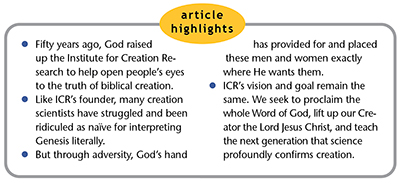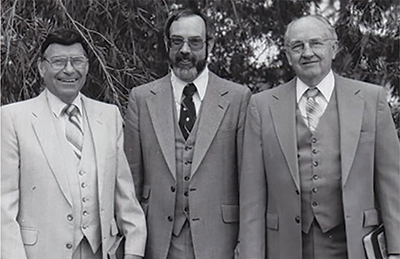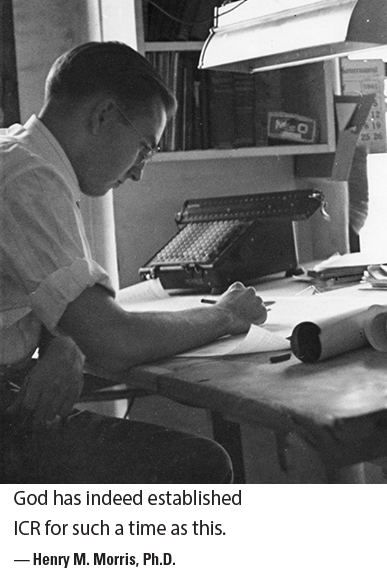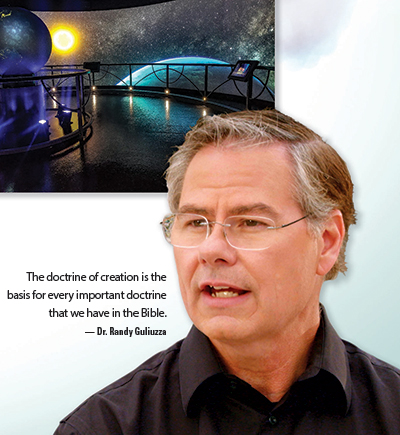 Each workday morning, the Institute for Creation Research staff meets for a time of devotion and prayer. Dr. Brian Thomas recently led our group and related how God’s hand and perfect timing played out in his journey to ICR. In the early 2000s, Dr. Thomas was a biotechnology professor at a Christian university. In 2007, he was told by the dean of the science department that his contract wouldn’t be renewed for the following academic year—he was let go. That was quite a serious blow to this father of five.
Each workday morning, the Institute for Creation Research staff meets for a time of devotion and prayer. Dr. Brian Thomas recently led our group and related how God’s hand and perfect timing played out in his journey to ICR. In the early 2000s, Dr. Thomas was a biotechnology professor at a Christian university. In 2007, he was told by the dean of the science department that his contract wouldn’t be renewed for the following academic year—he was let go. That was quite a serious blow to this father of five.
Taking a Stand
Why this sudden turn of events at the university? It was almost certainly because Dr. Thomas held to biblical creation. He took a stand to uphold the whole Word of God. Years earlier, while Dr. Thomas was still an evolutionist, God had revealed to him a clearer understanding of both Scripture and science and how they fit together, which allowed him to see an aspect of truth many others don’t.1 From then on, he wouldn’t back down from proclaiming it. And people’s eyes were opened.
After his dismissal, Dr. Thomas looked for other teaching positions, filling out countless applications and even considering changing careers to a completely different field. Through a divine appointment, a friend mentioned that ICR had a position open for a science writer. Dr. Thomas interviewed, was hired, and began working at ICR right after receiving his last paycheck from the university. Our God provides.
Other creation scientists have had similar experiences when they took a stand—job loss, advancement opportunities curtailed, even ridicule from fellow Christians—and others gave up lucrative careers to advance biblical creation. But God’s hand has been in all their circumstances, sovereignly putting each piece in place. And people’s eyes have been opened.

Celebrating 50 Years
The Institute for Creation Research was formed a half-century ago by Dr. Henry M. Morris, who envisioned a creation science ministry founded first and foremost on the inspired Word of God from Genesis to Revelation.
Dr. Morris’ experience with standing for biblical creation was much like those of creation scientists today. He was appointed the Civil Engineering Department head at Virginia Polytechnic Institute in 1957 and published his groundbreaking book The Genesis Flood with Dr. John Whitcomb in 1961. Soon afterward, as his notoriety grew as an outspoken creationist, his position was threatened. But he continued to take a stand—he would not remain silent. By 1969, Dr. Morris was told he would no longer be the head of the department. That event was a turning point that led him to found ICR the next year. Dr. Morris hadn’t planned this journey, but God had it in mind all along and led and equipped him through every step. People’s eyes were opened, and the modern biblical creation movement flourished.
 Dr. Morris penned his ongoing vision for his organization in a July 1995 Acts & Facts article commemorating ICR’s 25th anniversary: “[A] key purpose of ICR is to bring the field of education—and then our whole world insofar as possible—back to the foundational truth of special creation and primeval history as revealed first in Genesis and further emphasized throughout the Bible.” He went on the say that “the young people in our colleges and universities will probably be the leaders of tomorrow in every field of human activity. There can be no more vital goal than to provide as many of them as possible with a solid biblical, Christian, creationist education.”2
Dr. Morris penned his ongoing vision for his organization in a July 1995 Acts & Facts article commemorating ICR’s 25th anniversary: “[A] key purpose of ICR is to bring the field of education—and then our whole world insofar as possible—back to the foundational truth of special creation and primeval history as revealed first in Genesis and further emphasized throughout the Bible.” He went on the say that “the young people in our colleges and universities will probably be the leaders of tomorrow in every field of human activity. There can be no more vital goal than to provide as many of them as possible with a solid biblical, Christian, creationist education.”2
The truth of creation is often dismissed because evolution is so entrenched and widespread among Christians and Christian institutions that believers often side with what they see as science rather than the Bible’s clear revelation. ICR seeks to enlighten learners of all ages and show them that science and the Genesis narrative completely align.
When sharing his career story, Dr. Thomas stated, “ICR exists so people can hear the alternative to what they are being told about origins; for example, the story that they came from primates. But good science agrees with Adam and Eve.” We exist to demonstrate evolution’s scientific failings—and the logical fallacies some scientists use to defend it—and replace them with the limitless evidence for biblical creation.
The Great Opportunity
ICR’s new president, Dr. Randy Guliuzza, has degrees in engineering, medicine, and public health, as well as theology. He recently said, “My view of science has probably come down, realizing that it can be abused, and my view of the Bible has gone up, recognizing that it really, really is accurate, and it is so full of wisdom that I just hold it in awe and respect.”3
He also sees great opportunity in ICR’s future and wants to encourage a new creation movement:
I would love to see ICR become a leader in helping pastors and Christian leaders see biology in a completely different light, in a way that they have never seen it before, and that it will build their faith and strengthen their belief in the Bible as authoritative and accurate. And that will help them to lead their people to completely trust it and to obey it….If we can have ICR leading the way in a second creationist revival, and we’re doing that by developing a solid theory of biological design, that would be a major accomplishment.3
Dr. Henry M. Morris’ great idea, the one that got him dismissed and led to an even greater purpose, was based on how Earth’s geology—its vast sedimentary layers—was shaped by Noah’s Flood. He was a great scientist, writer, and speaker, and his message was clear, concise, compelling, and communicable.
Now, as others carry forward what he started, the next area creationists must address is biology—life itself. Misleading evolutionary biology must be brought to light and countered with a design-based model and organism-focused approach in which creatures are seen as wholly active rather than passive—a model backed by the undeniable evidence of the intentional design of the Creator. Organisms are clearly engineered at the highest level to innately respond to and thrive in the environments in which they are found, and much of that evidence comes from secular science.
ICR will continue doing groundbreaking research, Lord willing, for the next 50 years as we have from the beginning, “interpreting the scientific data in the context of biblical revelation.”2 Our current research focuses on creatures’ innate ability to adapt to environmental changes, global geological Flood evidence, the uniqueness of the human genome, the problems with radioisotope dating, discoveries of fossil tissues that can’t be millions of years old, Ice Age and climate research, time dilation in deep space, light travel from distant stars, signs of youth in the solar system, historical and scholarly discoveries that match the Bible, and wherever else our research leads us.
Worth the Commitment
 The scientific and historical case for biblical creation isn’t simply strong—it’s profound. Since the Christian faith is defendable from every angle, no one has to take off their “science cap” to be a believer. We at ICR are wholly committed to empirical science because each new discovery reveals the glory of the Creator as it’s displayed in His creation.
The scientific and historical case for biblical creation isn’t simply strong—it’s profound. Since the Christian faith is defendable from every angle, no one has to take off their “science cap” to be a believer. We at ICR are wholly committed to empirical science because each new discovery reveals the glory of the Creator as it’s displayed in His creation.
Our vision is the same as it was in 1970—we seek to lift up Christ Jesus as Creator and Redeemer to an ever-multiplying audience. Our goal is the same—to educate the next generation and demonstrate how the Bible and science confirm each other. We are surrounded by overwhelming evidence of design, and we seek to continue to open people’s eyes to God’s glorious creation and liberate their thinking.
This message isn’t new…it’s as old as creation itself. There’s a great opportunity before us, and it’s worth the commitment of time, resources, struggle, and prayer to reach and educate a new generation.
References
- Thomas, B. 2020. Why Do I Believe in Recent Creation? Acts & Facts. 49 (7): 20.
- Morris, H. M. 1995. Reflections on Fifty Years in Creation Evangelism (I: ICR, For Such a Time as This). Acts & Facts. 24 (7).
- Hardy, C. 2020. Dr. Randy Guliuzza, ICR’s New President and Chief Operating Officer. Acts & Facts. 49 (9): 5-7.
* Mr. Stamp is an editor at the Institute for Creation Research.




















